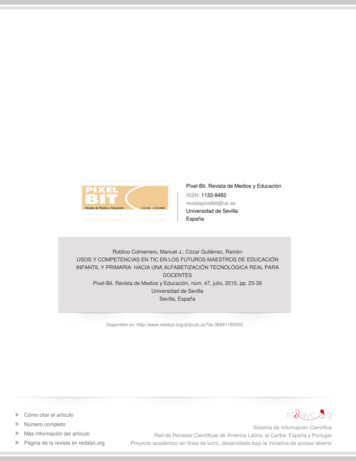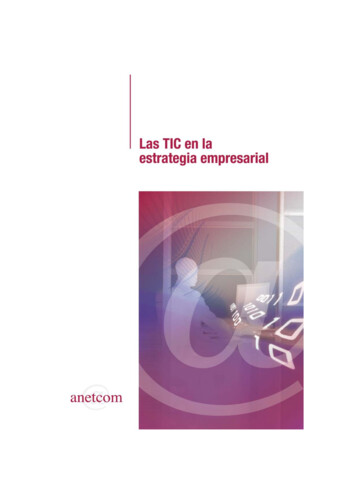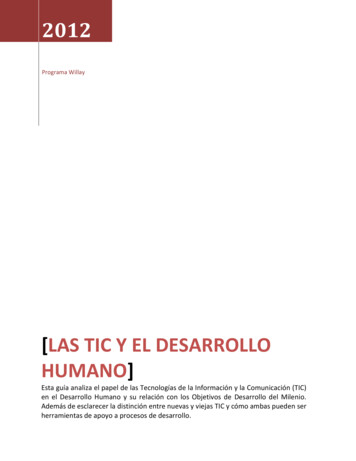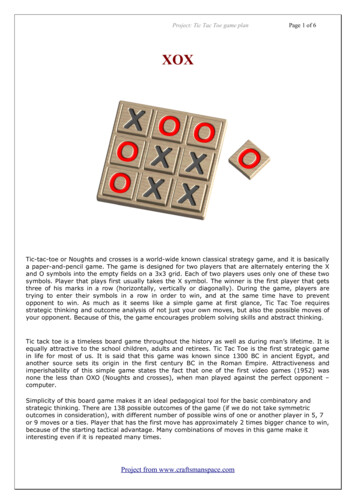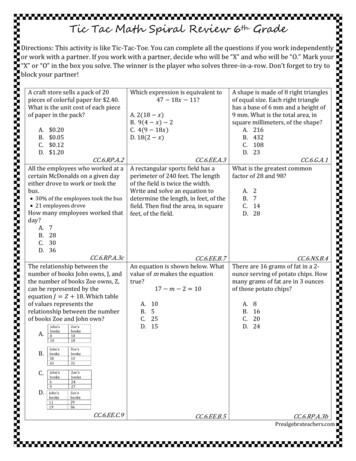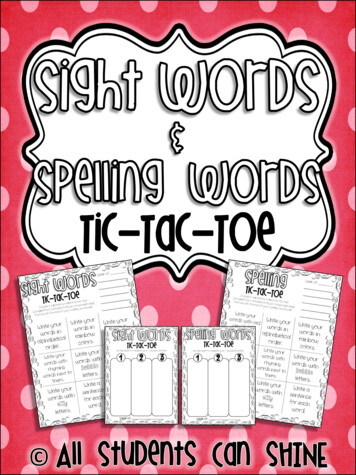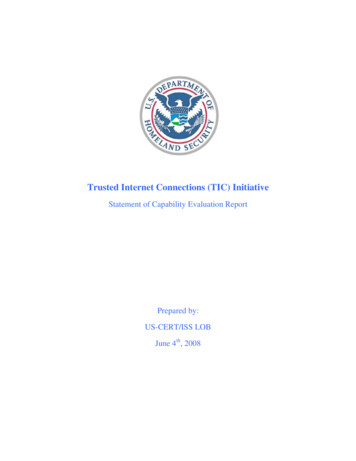
Transcription
AI Approaches to Ultimate Tic-Tac-ToeEytan LifshitzDavid TsurelCS DepartmentHebrew University of Jerusalem, IsraelCS DepartmentHebrew University of Jerusalem, IsraelI.INTRODUCTIONThis report is submitted as a final requirement for theArtificial Intelligence course. We researched AI approaches tothe game of Ultimate Tic-Tac-Toe, including aspects of gametrees, heuristics, pruning, time, memory, and learning.II.RULESUltimate Tic-Tac-Toe is a variation of Tic-Tac-Toe whichis more challenging than regular Tic-Tac-Toe for a computer.The board consists of 9 small 3-by-3 boards, which togethercompose a large 3-by-3 board.In this example, the blue player played the top-right squarein the bottom-left small grid, so the red player must now playhis turn in the top-right board (colored in yellow).If all squares in the small board have been exhausted, or ifthe board has already been won, the player may choose tomake his move anywhere on the board.III.Players take alternating turns, and a player wins a smallboard just like regular Tic-Tac-Toe, by placing three of hissymbols in a row. When a player wins a small board, they puttheir symbol in its position in the large board. The game endswhen one of the players gets three symbols in a row in thelarge board, or in a tie if all squares have been exhausted.To make gameplay more interesting, a player must placetheir symbol in the small board that corresponds to theposition in the small board of the previous move:EVALUATIONTo evaluate the different agents used in the project, ourmain statistical tool will be the binomial test. Because it is anexact statistical test of the statistical significance, we can getaccurate p-values and not just approximations.[1] In eachevaluation of two agents, we will present n (number of gamesplayed), the percentage of games won by each player, and thep-value of the results. The starting player will be chosenrandomly for each game. Our null hypothesis will usually bethat the players have equal strength and will therefore win anequal number of games. We use the two-tailed variation of thebinomial test to test if either player is better. Tied games arecounted as a half-win for each player.In other cases, we will want to test the hypothesis that twoplayers have the same strength (e.g. minimax and alpha-beta),so our null hypothesis will be that they are unequallyproportioned. We will use a proportion test with a confidencelevel of 0.95, and accept if the p-value of Pearson'schi-squared test statistic for 1 degree of freedom is larger thanthe commonly accepted threshold of 0.05.[2]
IV.TREE-TRAVERSAL ALGORITHMSWe used three basic search algorithms to traverse the gametree: the Minimax algorithm to traverse the whole tree, theMinimax algorithm with alpha-beta pruning to decrease thenumber of paths observed by the algorithm, and theExpectimax algorithm, that takes the expectation of the otherplayer's values instead of their minimum. (We used theBerkeley AI course assignments as a basis for several stages ofthe project.)The game tree is too deep for these algorithms to traverse inreasonable time, so heuristics are used to approximate the valueof nodes of a certain depth (described in the next section).Depth is denoted using the Berkeley notation, where a singlesearch ply is considered to be a move for each player.A random agent was easily defeated even by the simplestagents. A very basic Alpha-Beta agent using the simplestheuristic (heur1) and a depth of 2 won 96.35% of games(n 10,000; p-value 10-320) against a random agent. AnAlpha-Beta agent using the heur3 and a depth of 2 won 99.4%of games (n 1,000; p-value 10-280) against a random agent.2) Our second heuristic (heur2) takes into considerationmany more features of the given board: small board wins add5 points, winning the center board adds 10, winning a cornerboard adds 3, getting a center square in any small board isworth 3, and getting a square in the center board is worth 3.Two board wins which can be continued for a winningsequence (i.e. they are in a row, column or diagonal without aninterfering win for the other player in the third board of thesequence) are worth 4 points, and a similar sequence inside asmall board is worth 2 points. A symmetric negative score isgiven if the other player has these features.3) Our third heuristic (heur3) uses the fact that there areonly 39 19683 possible configurations for any small board.In the following board, for example, the top-left small boardand the top-right small board are identical and will beevaluated with the same score.Alpha-beta agents should return identical results tominimax agents, only faster. Indeed, when comparing analpha-beta agent to a minimax with the same heuristic anddepth, the results were 49.6% wins for the minimax agent(n 1,000; χ2 0.098; p-value 0.7542), so the agents are indeedsimilar in strength. Their speeds were quite different – whencomparing agents of depth 2, the minimax agent took anaverage of 1,033 milliseconds to make a move, against just 55milliseconds for an alpha-beta agent (n 10).Expectimax agents should be better against random agents,but since our minimax agents already defeat random agents,this is not such a big advantage. Indeed, when running anexpectimax agent against a random agent, it won 100% of thetime (n 100; p-value 10-30), better than minimax agents whichalso tied and lost some games. When testing an expectimaxagent against a minimax agent with depth of 2 and heur3, theminimax agent won convincingly with 78% of games (n 100;p-value 10-7).How important is search depth? An alpha-beta agent ofdepth 2 won 79.8% of games against an alpha-beta agent ofdepth 1 (n 1,000; p-value 10-80).An alpha-beta agent of depth 3 won 69.5% of games playedagainst a player of depth 2 (n 100; p-value 10-4) and 75.5% ofgames played against depth 1 (n 100; p-value 10-6).V.HEURISTICSWe used several heuristics:1) Our simple heuristic (heur1) evaluates winning andlosing with high absolute values: 10,000 for a winningposition and -10,000 for a losing position. In all otherpositions, the score is the number of small boards won minusthe number of small boards lost.We saved time by memoizing values for all possible smallboard configurations and using these values in our heuristic.This shortened the time spent on the heuristic considerably,from 68.243 microseconds on average on the second heuristicto 33.754 on the third heuristic.4) Our fourth heuristic (heur4) builds upon the previousheuristic, but takes advantage of an additional feature: if youare sent to a small board that is full or won you can playanywhere, so that add 2 points to the heuristic (and -2 for theother player).The weights of different features of these heuristics werechosen somewhat arbitrarily. We will return to these weightswhen dealing with learning agents.We tested the heuristics one against the other (heur2 wasnot tested here, since it is similar to the heur3, only slower).The third heuristic proved to outweigh the simplistic firstheuristic, winning 84.05% of games when playing with a depthof 2 (n 1,000; p-value 10-110). heur4 beat heur3 in 50.25% ofthe games, which means it is not significantly better (n 1,000;χ2 0.032; p-value 0.858).VI.TIMESo far we used a constant depth for our tree-traversingagents. But the importance of depth changes between different
stages of the game. In the early stages of the game, the searchspace is still quite large. In the endgame, the search space isconsiderably smaller, and the importance of moves for awinning result is much more critical. For comparison, aminimax agent using depth 3 will need to examine 81*9 6 43,046,721 positions, while a minimax agent using depth 5will need to examine just 11! 39,916,800 positions in anendgame with 11 empty squares (and probably less, since manyof the positions are terminal states or forced moves).of the turn currently played. The horizontal green line is usedas a reference for a constant time agent – if the line is above thethe blue line then the constant time player would have alsosucceeded in evaluating the move for depth 2, while if thegreen line is below the the blue line, it would have to return theevaluation of a shallower lever.We created a family of agents that run a bounded amount oftime for each move. A time-bounded agent evaluates a movewith an increasing depth (starting with 1), returning the actionwhich was deemed the best in the deepest level he managed toreach before his time ended. The agent also stops if it reachedthe bottom of the game tree.We first checked a mininax agent against an alpha-betaagent. As we have previous noted, an alpha-beta agent isidentical to a minimax agent when they run for a fixed depth,but takes considerably less time to reach the same result. Wenow use this extra time to advance to deeper levels of the gametree. Both agents were given 0.1 seconds to make a move,using heur3. The alpha-beta used his speed to win 71.15% ofgames (n 1,000; p-value 10-40).Speed is important, but since the number of nodes growsexponentially with depth, the time needed to traverse the treealso grows exponentially with depth. Below is a log-scalegraph for the time needed for an alpha-beta agent to traverse agiven depth.This implies that time is important only if the agent passesthe threshold needed to fully compute the next level.We tested the strength of a time agent against a constantdepth agent. Both agents were alpha-beta agents using heur3.Below is a graph for the amount of time given to the timedagent plotted against its win rate.This graph shows the amount of time used by a constantdepth of 2 agent (blue line) plotted against the ordinal numberThis is the graph for a player of depth 3:We can see that the first move takes a long time tocompute, since there are 81 possible moves. We see a generaltrend of decline in the time needed until about 30-40 moves in,then a leap, probably because boards are starting to be filled upand players are sent to them, meaning they can play anywhere.We tested the time agent against a constant depth agent.This is the graph for the winning odds of a time-bounded agent,plotted against the amount of time it was given. Here is thegraph when playing against a player of constant depth 2:
Again, we see that more time helps an agent win moregames, but due to the exponential time gap between levels, theslope levels off.In conclusion, time-bounded agents have the advantage ofbeing able to quickly compute many levels of the tree, which isespecially important in endgame positions. They do have theirdrawbacks, however, since they aren't as efficient in positionswhich do require a large computational effort, which are thepositions where the player is not limited to a single smallboard. They are also wasteful in the sense that thecomputational power is wasted if the timeout happened beforethe level was completed. Due to the exponential gap betweenlevels, this can be quite a considerable proportion of the time.VII.Here is the graph of a time-bounded player against a playerof constant depth 3:MEMORYWe have previously used memoization in the constructionof heur3, keeping the values of small boards. We will nowbuild agents using transposition tables, saving time instead ofrecomputing positions that were already evaluated.Our first agent is a basic one, which just savescombinations of boards and depths in a transposition table, andchecks every position it gets to see if it has already beenevaluated. An infinite memory is unpractical (and after about200,000,000 boards the computer becomes unresponsive), sowe limited the agents memory size.We tested this agent with memory of 10 6 boards against thememory-less time-bounded agent. The results were quitesimilar for both agents: 50.5% (n 100, p-value 1), slightly infavor of the memory agent.We can see the agent getting better with more time,surpassing the constant depth agent somewhere between t 1and t 2. Adding more time after that does not change theoutcome significantly, due to the exponential time gap betweendepth 3 and depth 4.How much does adding time help against another timebounded player? We checked several timed agents against anagent with 0.1 seconds.This agent is not very efficient in his memory usage, sinceit remembers all positions it has encountered, but many of themare very rare and have a low probability of appearing again. Wetherefore created a new agent that works in a FIFO method,discarding the last used position once it encounters a newposition and it has reached the full capacity of memoryallocated. Again, we tested this agent with memory of 10 6boards against the memory-less time-bounded agent. Theresults were again very similar: 48% (n 100) for the memoryagent.We also tried to use the symmetry of rotation andreflection. For example, the following eight boards areequivalent, and should therefore have equal heuristic value.
This should help both in terms of time (we don't have toreevaluate the same board eight times) and in terms of memory(we only have to remember one representative of the group).When evaluating a position, the agent will check all 8 possiblerotations and reflection to see if their values were alreadyevaluated.In practice, however, this did not work well. The overheadcaused by hashing 8 different boards for every node of the treetook toll on the limited time, and when running a symmetryagent against a memory-less agent, the symmetry agent wononly 43.5% of games (n 100, p-value 0.19).Our memory agents until now computed the hashseparately for each board. The changes between boards arelocal and limited to adding a single symbol (or removing it,when returning upwards in a tree search). To speed up thehashing process, we tried a different hashing technique. Zobristhashing generates random integers in the range [0, 2 256] foreach possible element of the board: 81 squares of the board 2 possible symbols, one for each agent. The hash function of aboard is the bitwise xor of all elements. The random integersare large enough for hash collisions to be probabilisticallyimprobable. Updating the board between two consecutivestates is a matter of a single xor, making it much faster thanrecomputing the whole board. In practice, however, this agentproduced only a negligible advantage over a memory-lessagent, winning 52.5% of games (n 100, p-value 0.76).In conclusion, using transposition tables did not prove tobe advantageous. This is probably due to the exponentialnumber of possible boards growing in each turn.VIII. LEARNINGOur next family of agents uses learning to try and improveperformance. Our main direction is reinforcement learning, andQ-learning in particular.Our basic attempt was a learner for state-action pairs. Weinitialized a dictionary for every pair. After every move, weupdated the value of the pair using the difference between thevalues of the two consecutive positions, multiplied by somealpha value and a discount value. The score of a given positionwas defined as 500 for a winning position and -500 for a losingposition. In all other positions, the score is the number of smallboards won minus the number of small boards lost. (This is thesame as heur1). We divided the games into two stages – in thefirst half the player plays a random move with a certainprobability, and chooses the best stat-action pair with thecomplement probability. In the second half the player alwaysissues his policy.The results were disastrous – this player won only 0.5% ofgames against a regular alpha-beta agent (n 1,000,p-value 10280). This is due to insufficient feedback – onlyrarely will a player visit a state twice, and so the q-values arenot able to propagate properly.We then tried learning with features. Instead of a dictionarywith action-state pairs, we learn features of advantageousstates, and these features can be shared by many states.We initialized a weight vector for many features, previouslydescribed in the heuristics section (heur2). This time, weupdated the weight vector using the difference between statescores. However, this agent also failed miserably against analpha-beta agent. Again, it won just 0.4% of games (n 1,000,p-value 10280).It turns out that single transition Q-learning isn't fit for thisgame, since the rewards are so scarce the agent cannot learn inreasonable time. In contrast to games like Pacman, whererewards are frequent enough so the player has a chance to learnthe correct weights for the features.Further improvements are possible. It's possible toremember the whole history of a game, then update the featurevector at the end of the game with all moves played during thegame, not just the last one. It's also possible to learn values forall possible binary feature vectors. We did not implement theseagents, but conjecture they will show better performance.IX.SHOULD YOU GO FIRST OR SECOND?We can also use the agents developed to determine otherquestions about the nature of the game.In game theory, Zermelo’s theorem states that for everydeterministic two-player game with perfect information, eitherone of the players has a winning strategy, or both players havestrategies that guarantee a tie. The theorem only proves theexistence of a strategy but does not include a constructiveproof.Some games have been analyzed and such strategies havebeen found. Regular Tic-Tac-Toe, for example, is a tied game ifboth players play optimally. Other games, like Chess, areharder to analyze. Does Ultimate Tic-Tac-Toe have a winningstrategy? Is it better to go first or second? We cannot give ananalytical model, but we can try to find a statistical answer. Weran two identical alpha-beta time-bounded agents (0.1seconds), and tested which player has a better chance ofwinning. The first player won 56.17% of games (n 300,p-value 0.05), meaning he has a statistically .org/wiki/Binomial t.htmlXKCD: Tic-Tac-Toe http://xkcd.com/832/
Ultimate Tic-Tac-Toe is a variation of Tic-Tac-Toe which is more challenging than regular Tic-Tac-Toe for a computer. The board consists of 9 small 3-by-3 boards, which together compose a large 3-by-3 board. Players take alternating turns, and a player wins a small board just like regular Tic-Tac-Toe, by placing three of his symbols in a row.

